位运算
- 内存的基本单元是字节,一个字节有8个位
一 位与 &
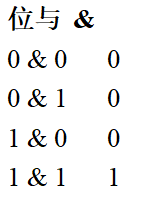
对应位, 都是1, 结果才是1
#include <iostream>
#include <Windows.h>
#include <bitset>
using namespace std;
int main()
{
int num1 = 0xa3; // 1010 0011
int num2 = 0x2f; // 0010 1111
const int width = 8; // width表示bitset声明的宽度,即有输出的二进制位数。
cout << (bitset<width>)num1 << " & " << endl;
cout << (bitset<width>)num2 << endl;
cout << "---------" << endl;
cout << (bitset<width>)(num1 & num2) << endl;
cout << "十六进制:0x" << hex << (num1 & num2) << endl;
system("pause");
return 0;
}
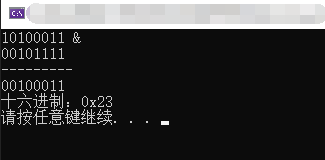
二 位或 |
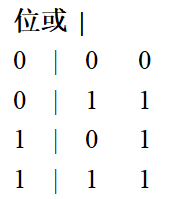
对应位, 都是0, 结果才是0
只要有一位是1, 结果就是1
#include <iostream>
#include <Windows.h>
#include <bitset>
using namespace std;
int main()
{
int num1 = 0xa3; // 1010 0011
int num2 = 0x2f; // 0010 1111
const int width = 8; // width表示bitset声明的宽度,即有输出的二进制位数。
cout << (bitset<width>)num1 << " | " << endl;
cout << (bitset<width>)num2 << endl;
cout << "---------" << endl;
cout << (bitset<width>)(num1 | num2) << endl;
cout << "十六进制:0x" << hex << (num1 | num2) << endl;
system("pause");
return 0;
}
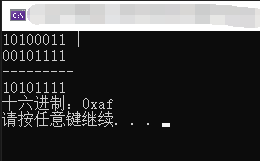
三 位非 ~
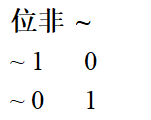
按位取反
#include <iostream>
#include <Windows.h>
#include <bitset>
using namespace std;
int main()
{
int num = 0xa3; // 1010 0011
const int width = 32; // width表示bitset声明的宽度,即有输出的二进制位数。
cout << (bitset<width>)num << " ~ " << endl;
cout << "---------------------------------" << endl;
cout << (bitset<width>)(~num) << endl;
cout << "十六进制:0x" << hex << (~num) << endl;
system("pause");
return 0;
}
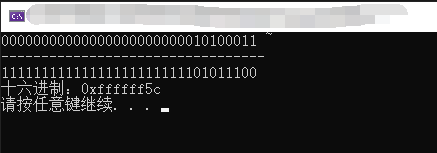
四 异或 ^
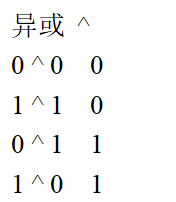
相同为0,不同为1
#include <iostream>
#include <Windows.h>
#include <bitset>
using namespace std;
int main()
{
int num1 = 0xa3; // 1010 0011
int num2 = 0x2f; // 0010 1111
const int width = 8; // width表示bitset声明的宽度,即有输出的二进制位数。
cout << (bitset<width>)num1 << " ^ " << endl;
cout << (bitset<width>)num2 << endl;
cout << "---------" << endl;
cout << (bitset<width>)(num1 ^ num2) << endl;
cout << "十六进制:0x" << hex << (num1 ^ num2) << endl;
system("pause");
return 0;
}

五 左移 <<
右边的位用 0 来填充, 移动超出左边边界的位则直接抛弃。
向左移动 n个位置,就等同于乘以 2的n次方
#include <iostream>
#include <Windows.h>
#include <bitset>
using namespace std;
int main()
{
cout << (bitset<8>)10 << " << 3" << endl;
cout << (bitset<8>)(10 << 3) << endl;
system("pause");
return 0;
}
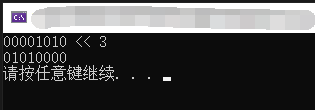
六 右移 >>
如果左操作数是无符号类型,则左边多出来的位用 0 来填充。
如果左操作数是有符号类型,则左边多出来的位用 符号位(最高位) 来填充。
向左移动 n个位置,就等同于除以 2的n次方
#include <iostream>
#include <Windows.h>
#include <bitset>
using namespace std;
int main()
{
int num = 0xc3; // 1100 0011
cout << (bitset<8>)num << " >> 3" << endl;
cout << (bitset<8>)(num >> 3) << endl;
system("pause");
return 0;
}

七 应用
例:把一个整数的的最低4位设置为0110
#include <iostream>
#include <Windows.h>
#include <bitset>
using namespace std;
int main()
{
int num = 0;
cout << "请输入一个整数:";
cin >> num;
cout << "十六进制:0x" << hex << num << endl;
// 1 先将这个整数的最低4位清0
num = num & (~0xf);
// 2 把最低4位设置为0110
num = num | 0x6;
cout << "num的二进制" << (bitset<16>)num << endl;
cout << "num的十六进制:" << hex << num << endl;
system("pause");
return 0;
}
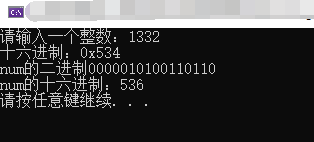



 浙公网安备 33010602011771号
浙公网安备 33010602011771号